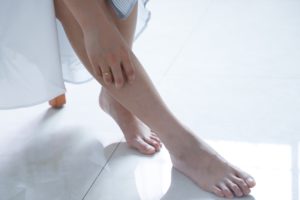 Chronic foot or ankle pain interferes with active lifestyles, limiting mobility and independence. No matter your age, it makes even the most basic activities, like going to the market or taking an after-dinner stroll, difficult. “I hate to hear that foot pain is preventing someone from participating in everyday activities,” said Dr. Kerry Zang, podiatric medical director of Comprehensive Integrated Care, Foot and Ankle. “It doesn’t matter if you are suffering from arthritis, an old injury, Achilles tendonitis, plantar fasciitis or heel pain, there are new therapies [referred to as regenerative medicine] that are able to repair and restore tissue, ligaments and joints. This also can apply to continued pain after surgical care.”
Chronic foot or ankle pain interferes with active lifestyles, limiting mobility and independence. No matter your age, it makes even the most basic activities, like going to the market or taking an after-dinner stroll, difficult. “I hate to hear that foot pain is preventing someone from participating in everyday activities,” said Dr. Kerry Zang, podiatric medical director of Comprehensive Integrated Care, Foot and Ankle. “It doesn’t matter if you are suffering from arthritis, an old injury, Achilles tendonitis, plantar fasciitis or heel pain, there are new therapies [referred to as regenerative medicine] that are able to repair and restore tissue, ligaments and joints. This also can apply to continued pain after surgical care.”
Until recently, anti-inflammatory medication and steroid injections, like cortisone, offered the best chance for relief. But, these options just reduced the symptoms. They did nothing to treat the problem actually causing the pain. “While cortisone stops the swelling and pain, it can also interfere with the healing process and further degeneration can occur,” explained Zang.
“Now, instead of just making the symptoms go away, we can deal with the underlying problem that is causing the pain. With regenerative medicine, we can help the body initiate its own healing response,” explained Zang. “The goal is to encourage a healing process where the body replaces, repairs, reprograms and renews diseased or injured cells. As new and healthy tissue forms, it helps improve function and resolve pain.”
Regenerative injection therapy (RIT) uses amniotic-derived fluid, also called growth factor injections, to treat chronic pain caused by arthritis, injured ligaments, tendons and joints. It may also be helpful in reducing the discomfort of neuropathy. These injections stimulate the body’s own natural healing process to repair chronically damaged tissue.
“When tissues are injured, the body responds naturally with inflammation and swelling. This is the body’s way of repairing itself,” continued Zang. RIT works in conjunction with the body’s natural ability to heal. Adding growth factors jumpstarts and maintains regeneration of new tissues, which help strengthen and repair damaged areas. “We’re adding neutral growth factors, which receive signals as to what kind of tissue to repair. Then, native growth factors and stem cells are attracted to the area to accelerate the regenerative process,” said Zang.
As we age, the regenerative process slows down. “If a degenerative process has started, sometimes the body needs a little boost to encourage the regenerative process,” she said. “Think of it like a boat with a hole in it. Water coming in represents the degenerative process, and bailing it out represents the regenerative process. When pain continues, it’s because there’s more water coming in than going out. When we supply growth factors, it’s like replacing a tablespoon with a bucket to bail the water out faster, so the hole can be repaired.”
A recent patient of Dr. Zang’s has seen wonderful results from his RIT treatments. The patient had been suffering from ankle pain since an injury caused him to have heel surgery three years ago. Cortisone injections, physical therapy and pain medications did not help, and he had been wearing a brace regularly because his ankle was unstable and painful.
“Additional surgery wasn’t an option for this gentleman because while it may have addressed his ankle problem, I believe it would have just transferred the pain further up his leg, and most likely affected his knee,” explained Zang. “I felt his best option was a growth factor injection because it offered the potential for significant relief.”
Zang recognized that the patient was skeptical, and explained, “I’ve seen excellent results with ongoing pain after prior surgeries, and believed he had on opportunity to benefit as well. I advised him it would take a bit of time to work, but it may offer the relief he needed.”
A few months after the injection, the patient noticed the pain was nearly gone. Then, a few weeks ago, he realized, “I [haven’t] noticed any pain…this is an unbelievable outcome so far, and I thought this could never happen. The shot works!”
Dr. Zang encourages those living with chronic foot or ankle pain to look into regenerative medicine. “Don’t wait to get help. The earlier you see a doctor, the sooner treatment can begin, increasing the potential for a successful outcome. Delaying care can put you at risk for further damage,” said Zang. “However, if you have put off treatment, don’t think it’s too late. I think the most important thing to keep in mind is that medicine is constantly changing and you should never lose hope.” FBN
By Reisha Zang
Reisha Zang is director of patient education at CIC Foot and Ankle. She can be reached at 480-860-6455 or reisha.zang@ciccenters.com.





